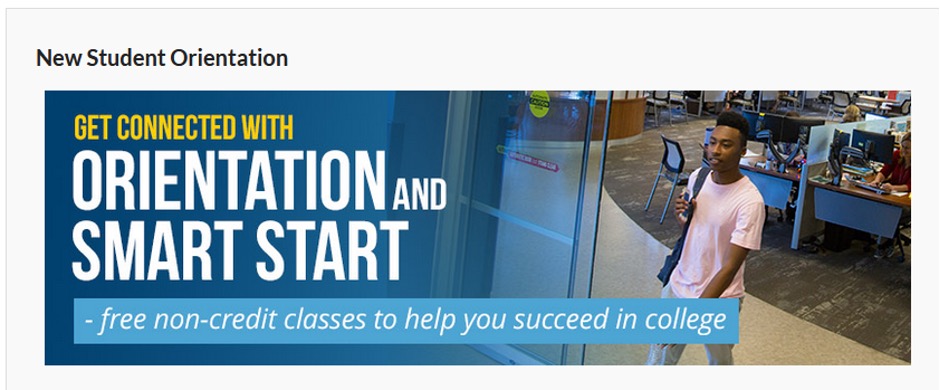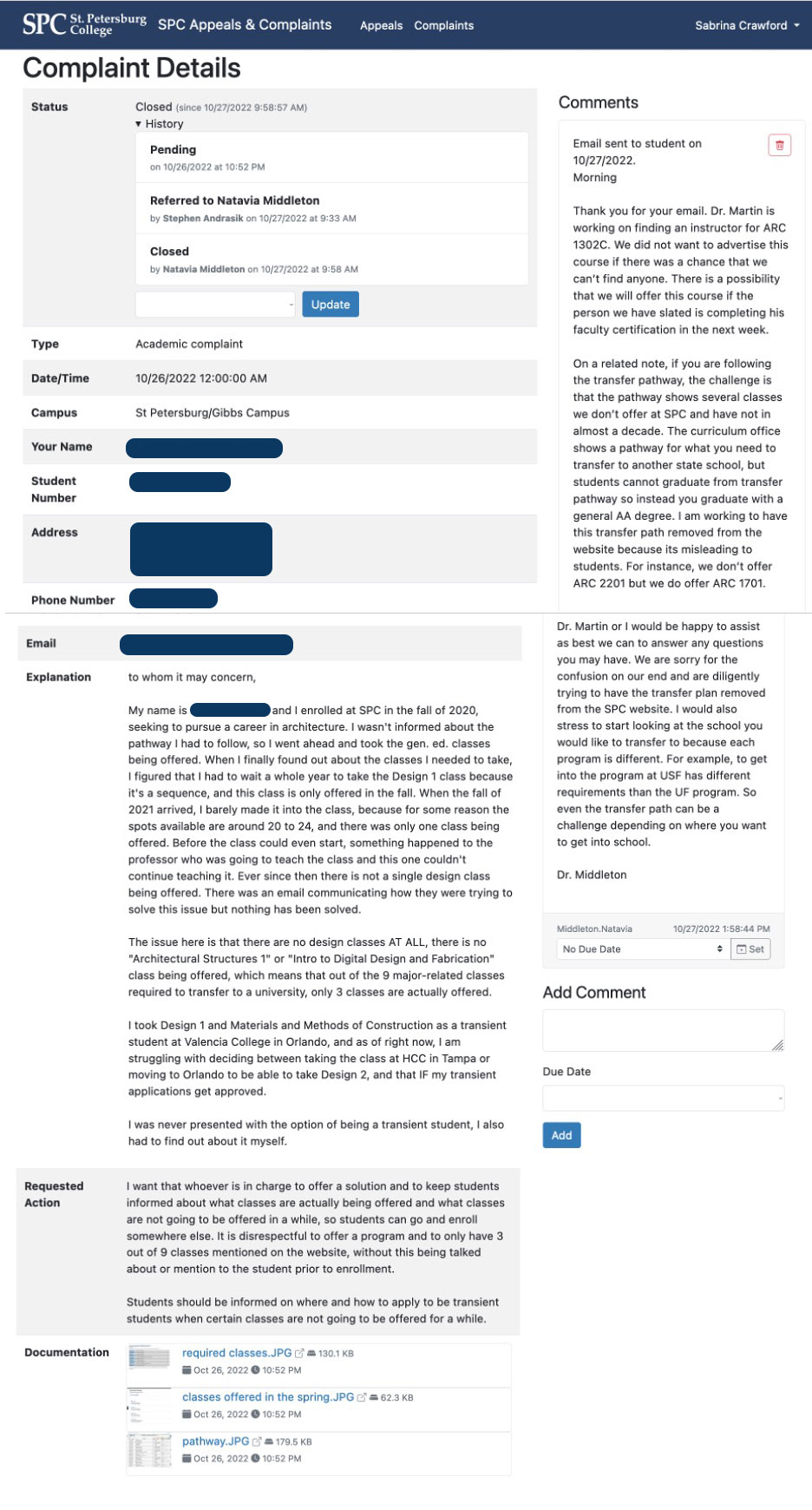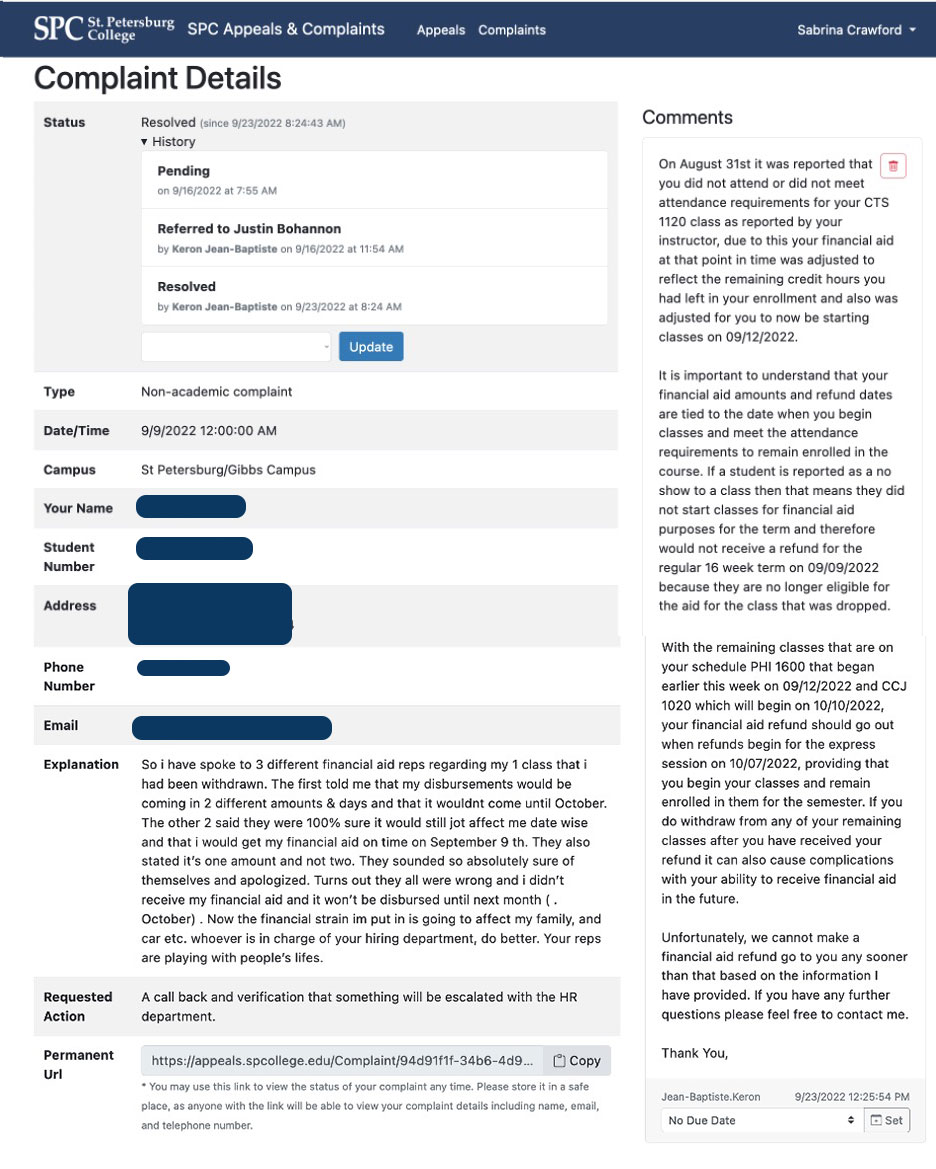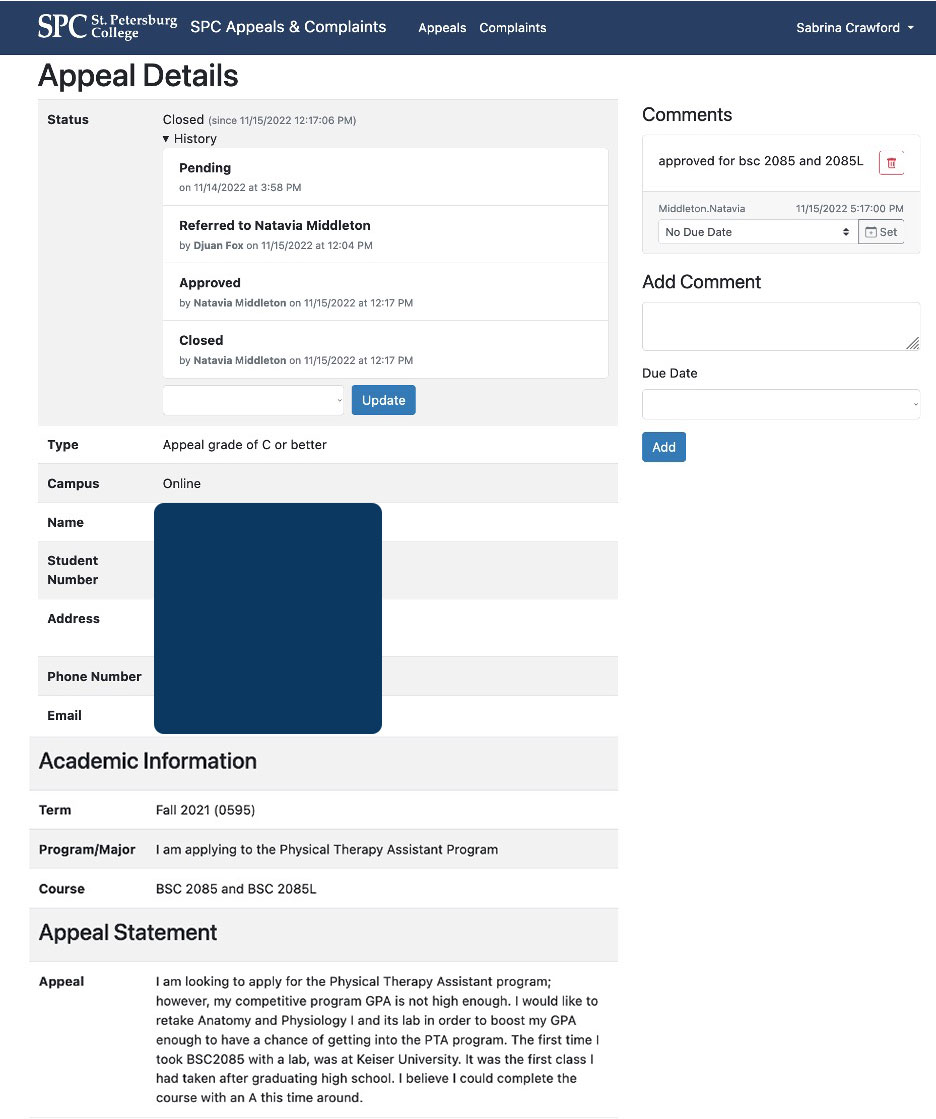12.4 Student Complaints
The institution (a) publishes appropriate and clear procedures for addressing written student complaints, (b) demonstrates that it follows the procedures when resolving them, and (c) maintains a record of student complaints that can be accessed upon request by SACSCOC. (Student complaints)
√ Compliance ____Non-Compliance
Narrative
St Petersburg College (SPC) (a) publishes appropriate and clear procedures for addressing written student complaints, (b) demonstrates that it follows the procedures when resolving them, and (c) maintains a record of student complaints that can be accessed upon request by SACSCOC.
At SPC, student concerns fall into the following categories as “written complaints”:
- Complaints: Complaints focus on dissatisfaction with experience with or treatment by a college employee to a matter relating to college facilities. Complaints may be academic (classroom, library, learning support) or non-academic (student services, auxiliary services or SPC buildings, parking lots, etc.).
- Appeals: Appeals may be academic or non-academic in nature and are a formal request asking for a change in a decision made. They occur after a student has had an action taken against them by the College that they deem unfair or in violation of their rights.
- Grievances: A grievance is an action where an individual alleges that his or her rights have been violated without rational basis or done in bad faith. Grievance submissions focus upon discrimination (Title IX) and sexual harassment/misconduct (Title VII).
SPC has established appropriate and clear procedures to address student complaints, appeals, and grievances that apply to all students on all campuses and instructional locations, including distance education and Dual Enrolled students. Each type has identified individuals/offices responsible for the maintenance of the record(s).
Table 12.4.1 — Responsibility for Resolving Complaints and Maintenance of Records
Campus Associate Provost or Testing Coordinator
Campus Associate Provost
Associate Deans or Deans
Assistant Director of Records
SITE MAP
Part I: Signatures Attesting to Integrity
Part II: Institutional Summary Form Prepared for Commission Reviews
Part III: Fifth-Year Compliance Certification
- Section 5: Administration and Organization
- Section 6: Faculty
- 6.1 Full-Time Faculty
- 6.2b Program Faculty
- 6.2c Program Coordination
- Section 8: Student Achievement
- Section 9: Educational Program Structure and Content
- 9.1 Program Content
- 9.2 Program Length
- Section 10: Educational Policies, Procedures, and Practices
- Section 12: Academic and Student Support Services
- 12.1 Student Support Services
- 12.4 Student Complaints
- Section 13: Financial and Physical Resources
- Section 14: Transparency and Institutional Representation
Part IV: Follow-Up Report (not applicable)
Part V: Impact Report of the Quality Enhancement Plan
Supporting Documentation
- Board of Trustees Rule 6Hx23-4.362
- Board of Trustees Procedure P6Hx23-4.362
- Appeals and Complaints Submission Website
- Complaint Form
- Academic Appeal Form
- Non-Academic Appeal Form
- Non-Academic Appeal ADA Form
- EA/EO OneDrive Site
- Title VII Discrimination Form
- Title IX Sexual Harassment Form
- Equal Access/ Equal Opportunity Website
- Title IX Website
- Board of Trustees Procedure P6Hx23-4.363
- Board of Trustees Rule 6Hx23-4.36
- Board of Trustees Procedure P6Hx23-4.36
- Board of Trustees Rule 6Hx23-1.34
- Board of Trustees Procedure P6Hx23-1.34
- Board of Trustees Rule 6Hx23-2.011
- Board of Trustees Procedure P6Hx23-2.011
- Board of Trustees Rule 6Hx23-4.332
- Board of Trustees Procedure P6Hx23-4.332
- Respect Poster
- Student Handbook (p.49)
- 2022-23 College Catalog (p. 33, 67-70)
- Mutual Resolution of Dispute Form
EA/EO Officer – Intake Processor
Complaints will follow the chain of command unless it is filed against a reviewer.
Should a student not be satisfied with the outcome of an appeal per Board Rule and Procedure 6Hx23-4.362, they may appeal to the Office of the Student Ombudsman on matters related to the student’s access to courses and credit granted towards their degree.
Record Location & Elements of Submission Forms
Complaints and Appeals
All complaints and appeals are stored in a centralized electronic repository with forms for submission accessible to students via the Appeals and Complaints submission website. On this site, students can pick the type of appeal or complaint they want to submit by clicking on the blue submission button, which will auto-populate with the student’s basic information and identify the type of submission is being sent.
Form elements on these submissions all include the student’s name and ID number, contact information, the date the complaint was filed, the subject of the complaint/appeal, the name of the program or department that the complaint refers to, the category of the complaint/appeal (academic or non-academic), and space to add details regarding the complaint/appeal (forms slightly differ depending upon the type being submitted). Follow-up information includes the complaint status (in progress or resolved), supporting documents, and the resolution with a copy of the College administrator’s response. In 2022, St. Petersburg College transitioned to a new database for complaints and appeals. All complaints and appeals from the prior database will be archived for five years.
Forms Examples:
Grievances
Grievances are managed through the Office of Organizational Culture and Engagement by the Executive Director of Organizational Culture and Engagement/Title IX Officer or Equal Access Equal Opportunity (EA/EO) Officer. Grievances are stored in a password protected EA/EO OneDrive site available only to the EA/EO officers. In 2021, St. Petersburg College transitioned to a new online repository for grievances, previously kept as printed files in the College’s legal offices. All prior hardcopy grievance files will be kept for three years after settlement.
Depending upon the nature of the grievance, forms for Title VII Discrimination Review Form or Title IX Sexual Harassment form found on the Equal Access/ Equal Opportunity EAEO (discrimination) website and Title IX (sexual harassment) website. Form elements include student name, contact information, name of alleged discriminating party(ies), campus and position/office of the party(ies), date of the incident, names and contact information of others who may have knowledge of the facts surrounding the incident, description of the incident, and the remedy being sought. Follow up information includes an intake interview, and depending on the nature of the grievance, there are several routes the follow up could take place. An example of this includes a No Contact order where the follow-up is a notification to the parties involved.
Policies and Procedures
The procedures for submitting complaints, appeals, and grievances are published on the college’s Complaints, Title IX, and EA/EO websites. In addition to the information shared on the website, the College has formal Board of Trustee Rules and Procedures regarding student complaints, appeals, and grievances:
- Student Ombudsman Office Rule 6Hx23-4.362 and Procedure P6Hx23-4.362
- Complaint Resolution Process Procedure P6Hx23-4.363
- Student Grievances and Appeals Rule 6Hx23-4.36 and Procedure P6Hx23-4.36
- Discrimination Grievances Rule 6Hx23-1.34 and Procedure P6Hx23-1.34
- Sexual Harassment and Relationships Policy Rule 6Hx23-2.011 and Procedure P6Hx23-2.011
- Sexual Violence and Misconduct Rule 6Hx23-4.332 and Procedure P6Hx23-4.332
All Board of Trustees Rules and Procedures are reviewed on an ongoing basis to ensure they remain current with practice. A Rules and Procedure Advisory Group made up of a cross-section of college personnel are responsible for this process.
Dissemination of Policies
SPC disseminates procedures throughout the College community to ensure they are available to all constituents, including face-to-face, blended, and online students, dual enrolled students, faculty, and staff. Students are first made aware of procedures regarding student complaints, appeals, and grievances during the College’s Smart Start Orientation. Smart Start is a free, non-credit course offered in blended and online formats. Smart Start is required for first-time SPC students seeking an A.A. or A.S. degree and students returning from suspension or dismissal.

Procedures are also published and disseminated to students by the following methods:
- Complaints and Appeals Webpages include a link to the procedure and to the Appeals and Complaint Submission website
- Discrimination Webpage and Title IX webpage (includes sexual harassment and sexual misconduct)
- RESPECT Poster
- SPC Student Handbook (online) or hard copies at each campus (p.49).
- College Catalog (p.33, 67-70)
- Board of Trustees Rules and Procedures Webpage (see above for specific Rules & Procedures)
- Student’s Right to Know Webpage (under student services) shown below

College employees, particularly those who work directly with students (e.g., faculty members, advisors, student services staff) are apprised of procedures via the Faculty Manual and meetings with their supervisors, who inform and train staff on details of the procedures, and how to use the College’s online student complaint process and repository.
Faculty Manual example:

Evidence of Following Procedures/Record-keeping & Tracking
Records of complaints and appeals are maintained and tracked electronically in a centralized, College-wide, restricted-access repository on a SharePoint site as shown below:

Access to the electronic repository is restricted; it is not made public and only approved employees can gain access by logging in with their college username and password. Records of complaints and appeals are maintained for three years from the time the complaint was lodged. After three years, records are retained in accordance with the state records retention requirements.
Process for Complaints and Appeals
A student lodges a complaint or appeal by submitting the online Submission Form. The online form is the primary method for receiving student complaints and appeals; therefore, students are referred to the online forms when they call or email staff regarding the process. A College employee may also submit a form on behalf of students who require accommodations or who are unable to utilize the online forms.
Within three business days from receipt of the submission, the appropriate College administrator (based on table 12.4.1) completes a thorough review of the submission and responds in writing to the student. After responding to the student, the administrator uploads supporting documents or artifacts regarding the submission to the electronic repository and updates the submission status as “in progress” or “resolved.”
To ensure that the procedure is followed within the time constraint outlined, the administrator receives an automated email message from the electronic repository on the second business day reminding the administrator of the time available to complete the review and respond to the student. The Vice President of Academic Affairs and the Vice President of Student Affairs manage the timely acknowledgment and response to student submissions and are notified by the electronic repository when there are outstanding submissions that have not been answered within the allotted timeframe. When necessary, the Vice Presidents will follow-up with the appropriate administrator(s).
If the student is not satisfied with the decision of an Appeal resolution, the student may appeal the decision by submitting an appeal in writing to the Campus Provost or Dean within 10 working days of receiving the decision. The Provost or Dean will review the decision, including the basis upon which the decision was made, and provide a decision in writing to the student within 10 days of receiving the appeal. The decision of the Provost or Dean is final.
Academic Complaint Example & Follow Up

Non-Academic Complaint Example & Follow Up

Academic Appeal Example & Follow Up

Non-Academic Appeal Example & Follow Up

Process for Discrimination, Sexual Harassment and Sexual Misconduct Grievances
Grievances pertaining to discrimination, sexual harassment, and sexual misconduct are handled by the Executive Director of Organizational Culture and Engagement/ Title IX Coordinator. Records are stored in an access-controlled database separate from the Complaints and Appeals, due to their sensitive nature, for a period of 7 years. As such, the examples shared below represent synopses of the events that occurred rather than the submitted forms and communication.
The Discrimination Grievance BOT Procedure P6Hx23-1.34 and Sexual Harassment/ Misconduct Grievance BOT Procedure P6Hx23-4.332 describe the processes used, which provide an avenue through which issues and claims related to discrimination based on a protected class and/or disability and sexual harassment/misconduct are addressed and resolved at the earliest possible juncture. They allow for both an informal and formal process through which allegations and claims may be presented free from coercion, interference, restraint, discrimination, or reprisal in order to give students an adequate opportunity to resolve the charges.
All grievance processes begin with the submission of either the Title VII Discrimination Review Form or Title IX Sexual Harassment form found on the Equal Access/ Equal Opportunity EAEO (discrimination) website and Title IX (sexual harassment) website, respectively. At this time, the complainant can decide whether or not they prefer to utilize the informal or formal resolution process. If the submitter does not indicate their preference, the Office of Organizational Culture and Engagement will first attempt to reach a satisfactory resolution through the informal process before proceeding through the formal process. The goal of informal resolution is to ensure that the alleged discriminatory or sexual harassment/misconduct conduct ceases and that the matter is resolved promptly through a mutual resolution process. During the informal process, the Executive Director of Organizational Culture and Engagement or the Title IX Coordinator will work with the submitter and may refer the matter to the appropriate Academic Dean, Associate Provost, or other campus administrators to get their input.
For matters not resolved using the informal process, the EA/EO Officer or Executive Director of Organizational Culture and Engagement/Title IX Officer will then conduct an investigation to determine the findings and offer any recommendations, which are communicated to the parties. If a dispute can be resolved by mutual agreement during the formal process, and as deemed necessary, a Mutual Resolution of Dispute Form may be signed by the parties. If the grievance is not mutually resolved, either party may request an appeal of the findings. The decision of the Appeals Officer is final.
Discrimination Complaint Example
Note: An example of a recent complaint is embedded in the document below.
On May 9, 2022, the College received written information from a student alleging discrimination based on race and national origin when the student was denied readmission to the nursing program.
Action Taken and Investigation: The EA/EO Office reviewed the discrimination element of this student’s complaint. The EA/EO Office conducted an initial review of the matter by reviewing the information and written documentation provided by the student, and speaking with the Dean and Associate Dean for the program.
Findings: Based on the allegations and after reviewing information submitted by the student, interviewing the Dean and Associate Dean for the program, and through a review of the admissions and readmissions of students in the program for the past 3 years, the findings showed that there was no discrimination or discriminatory patterns based upon race and national origin.
Conclusion: The student was advised that based on the informal review, there was insufficient information to support a claim of discrimination based on race or place of origin. The student did not continue to pursue the matter or initiate any additional formal complaint or process through the Equity Office and the matter was administratively concluded.
Sexual Harassment Complaint Example
On January 26, 2023, the College received written information from a student alleging inappropriate behavior of a sexual nature by another student. The student (respondent) was alleged to have made inappropriate sexual advances such as groping, kissing, and grabbing.
Action Taken and Investigation: Upon being made aware of this complaint, the Title IX/EAEO Office provided oversight and direction. During the intake process when options were presented, the student (complainant) indicated they wanted a No Contact Order. The No Contact Order was ordered, and the respondent student was notified via email and called to ensure the order was received and to answer questions. While there were no questions at the time, the student respondent understood they are not to contact the respondent.
Conclusion: The students have been separated via the No Contact Order and the student complainant did not pursue the matter further.
Sexual Violence and Misconduct Grievance Example
During the Fall of 2022, a female volleyball player expressed to her coach that she had been the victim of sexual misconduct by a male basketball player while living in off-campus housing (note that the college does not provide housing but does provide housing stipends for athletes).
Action Taken and Investigation: The volleyball coach immediately contacted the College Athletic Director, who in turn contacted St. Petersburg Police. The College suspended the male athlete from the team during the investigation and moved his campus classes to online sections to continue his education. In addition, the two teams’ schedules were reorganized to prevent team members from either team interacting on campus. The St. Petersburg Police arrested the male athlete and proceeded with the investigation.
Findings: The investigation determined that there was not sufficient evidence to press charges.
Conclusion: All charges were dropped. As this event took place off campus, the SPC internal, formalized process did not take place but instead was left in the hands of the local police department. The Coach, Athletic Director, and College Leadership remained informed throughout the process.

